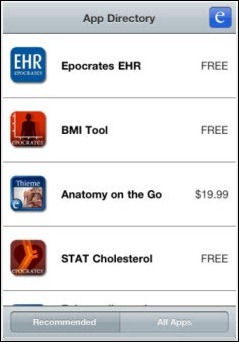The article about Pediatric Associates in CA has a nugget with a potentially outsized impact: the implication that VFC vaccines…
News 11/1/11
From Y-factor: “Re: American Academy of Ophthalmology meeting. Physicians are much more vocal about their experiences with EHR than administrators who don’t want to admit to their colleagues that they led a failed EHR implementation. At AAO, the exhibit hall was rife with physicians that were beset with their EHR implementations. This is just the tip of the iceberg. Meaningful Use-fueled EHR purchases with rushed implementations will exacerbate this situation.” Y-factor has participated in his share of MGMAs, as well as specialty-specific meetings like AAO. It’s an interesting observation, though I wonder how many of those physicians actually selected their own EHRs versus had their EHRs selected for them.
Central Ohio Primary Care Physicians, the country’s second-largest privately-owned primary care group, chooses eClinicalWorks EHR for its 230-physician practice.
MGMA calls on HHS to issue a contingency plan for HIPAA 5010, noting that many practices and their trading partners may not be ready by the January 1, 2012 deadline. MGMA research finds that about 25% of practices still have not yet heard from their software vendors regarding the transition and only 35% have begun their internal testing. MGMA contends that if all parties are not ready by the deadline, practices could face cash flow issues that affect their operations.
Special thanks to the reader who posted this on my Facebook page, just in time for Halloween. I am thrilled that the true meaning of this movie has finally been revealed in terms that I can relate to.
Overall EHR adoption in physician offices hovers around 40%, but exceeds 75% in practices with 26+ providers. The same study finds that EHR adoption rates are higher in practices with more exam rooms (because of the space they have recouped since their paper charts are gone?) and in practices with higher average patient volume.
SilverTree Health, a provider of physician billing and PM services, merges with Essential Health Care Solutions, a medical reimbursement consulting company.
Epocrates introduces Epocrates App Directory, which features reference, educational, and clinical apps for clinicians.
The Colorado REC adds Office Ally as an approved integration EHR vendor.
The Raleigh Hand Center (NC) selects the ChartLogic EHR Suite.
A Texas physician is sentenced to 11 years in federal prison for her role in a scheme that fraudulently billed Medicare and Medicaid $45 million over a 2 1/2 year period. A US district judge ordered Christina Joy Clardy to pay $15 million in restitution after finding she knowingly permitted fraudulent billing under her provider number.
The number of office visits per physician FTE dropped 8% in September compared to a year ago and the trend is likely to continue. Blame a tough economy, higher insurance deductibles, and efforts by health plans to reduce utilization.
Greenway Medical Technologies and ChartLogic become the first EHR solution providers to send controlled substance prescriptions electronically. Both companies are pilot participants in DrFirst’s EPCS Gold controlled substance e-prescribing program.
St. Peters Bone & Joint Surgery (MO) says it realized an annual savings of $30,000 by optimizing its Sage EHR with MD-IT’s EMR optimization software and iConnect for iPhone.
Chiropractors are getting their HITECH payments, too.
American Medical News highlights the growing popularity of texting between physicians, despite the risk of HIPAA violations. Though encryption-enabled devices exist, most physicians don’t have the tools in place and are more focused on the efficiency of text instead of its potential privacy risks. As the executive director of a hospitalist group points out, “Physicians are not so much concerned with HIPAA compliance as they are about work flow and physician communication.”
No surprise here: physicians’ overall satisfaction with their EHRs is correlated with their level of involvement in the EHR selection process. In addition, the more training clinicians receive, the higher the reported usability of advanced EHR features. At least three to five days of training is necessary to achieve the highest level of overall satisfaction.







